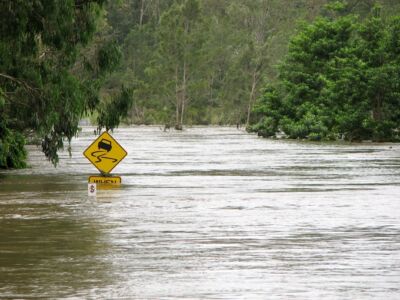Flood checklist: How to prepare for a flood & how to survive a flood
Canstar’s flood checklist includes emergency flood assistance resources and flood preparation tips for before, during and after a flood or flash flood. We’ve brought together government and emergency services information nationally. Remember: if it’s flooded, forget it.

Canstar’s flood checklist includes emergency flood assistance resources and flood preparation tips for before, during and after a flood or flash flood. We’ve brought together government and emergency services information nationally. Remember: if it’s flooded, forget it.
*As of 03/03/2025, Southeast Queensland and Northern NSW have been put on cyclone watch as Cyclone Alfred hovers off the southern Queensland coast. The Bureau of Meteorology (BOM) has classed the cyclone as a category 2 system, predicting it will “become slow moving and turn west towards the Queensland coast on Tuesday evening. Alfred’s intensity may fluctuate between category 1 and 2 later today and tomorrow, but is forecast to cross the southeast Queensland coast at category 2 strength late on Thursday or early Friday,” says the latest update from BOM.
Head to government website, Get Ready Queensland for information on how to prepare and secure your home for an extreme weather event.
Get emergency flood assistance now
Call your state or territory emergency service (SES) on 132 500 for emergency help in a flood, storm or tsunami. For a life-threatening emergency call Triple Zero (000). You can view the latest flood warnings for your area, state or territory on the Bureau of Meteorology (BoM) website.
Government services
For more information on flood preparedness, visit the government advice for your state or territory:
- ACT Emergency Services Agency
- NSW State Emergency Services (NSW SES)
- Northern Territory Government
- Queensland Government Get Ready Queensland
- South Australian State Emergency Services (SES)
- TasALERT (Tasmanian Emergency Information Service)
- Victoria State Emergency Services (SES)
- WA Department of Fire and Emergency Services
Detailed information about flood readiness is available from these websites above. For example, the NSW State Emergency Service (NSW SES) has information for people from culturally and linguistically diverse backgrounds. Flood safety resources are also available to support people who are deaf or hard of hearing, have limited mobility, have an intellectual disability, or have a visual disability.
People with a disability can use the National Relay Service to contact state emergency services. In NSW, for example, the NSW SES has an explanatory video available for how to seek support.
Compare Home and Contents Insurance
Flood preparation before a flood
How do you prepare for a flood? Here are eight tips for flood preparedness to help you protect yourself and your family, as well as your home and property.
1. Find out if you’re in a flood area
You can check the Australian Government’s Flood Risk Information Portal to estimate the risk of flood for your home. This portal has been developed between the state and territory governments and the insurance industry. It includes flood maps and flood studies, as well as details for surface water observations analysed with satellite imagery.
2. Check your insurance coverage
Having sufficient insurance to meet your personal needs – including home insurance, contents insurance and car insurance – can help you to have peace of mind in preparing for wild weather such as floods, damaging winds and storms. You can compare car insurance and home and contents insurance policies with Canstar.
If you already have insurance, but are unsure if it includes cover for flood damage, you may like to review your policy documents or contact your insurance provider to confirm what the policy includes. You may also be interested in our related pages, including:
- Flood Insurance: Flood Cover for Home Insurance
- How to protect your car from hail and storm damage
- Home insurance policies with hail and storm damage cover
- Natural disasters in Australia: what does the most damage?
3. Clean up outside and inside
Secure all loose items like outdoor furniture, garden tools, and children’s toys. If you can, lock them away inside or move them to a higher, more secure position. As for inside:
- Move as many items as you can to a higher position in your home, especially chemicals, oils, and anything that could float and cause damage.
- Roll up rugs.
- Secure anything that could be knocked over and create a hazard in a storm surge, such as heavy bookshelves. Put smaller electrical appliances up on tables and benchtops.
4. Charge your mobile phone
Charge your phone, tablet or iPad, laptop, and any other electronic equipment fully before the flood. That way, even if the power goes out, you can still make calls and check for updates on the storm.
5. Disconnect utilities
Once your phone is charged, unplug all your electrical appliances, as recommended by Ergon Energy, and turn off your home’s power at the switchboard. Also turn off the gas and water.
6. Prepare an emergency kit
Here are some important things to include in an emergency and/or evacuation kit.
Emergency kit essentials:
- Torches
- Battery-powered radio
- Extra batteries
- Clean drinking water
- Rubber gloves
- First aid kit
- Medications in a waterproof bag
- Identification and insurance documents, photo albums or other mementos in a waterproof bag
- Warm clothing, bedding and pillows – plan to stay overnight if you evacuate
- Food that won’t perish quickly
- A camp stove for boiling water and cooking food
- Waterproof bags.
7. Listen for announcements
Keep your radio on and tuned to your local station so that you can hear all important information. On the BoM website, you can find current flood warnings, and rainfall and river conditions.
8. Be a good neighbour
Now that you are prepared, check that your neighbours are also; especially if they are elderly, disabled, do not speak English well or have young children.
Compare Home and Contents Insurance with Canstar
If you’re comparing home and contents insurance policies, the comparison table below displays some of the policies currently available on Canstar’s database for an Australian aged under 50, seeking cover in NSW or the ACT for a cost to replace contents of below $75,000. Please note the table is sorted by Star Rating (highest to lowest), followed by provider name (alphabetical) and features links direct to the providers’ websites. Consider the Product Disclosure Statement (PDS) and Target Market Determination (TMD), before making a purchase decision. Contact the product issuer directly for a copy of the PDS and TMD. Use Canstar’s home insurance comparison selector to view a wider range of policies. Canstar may earn a fee for referrals.
 24/7 claims
24/7 claims
 New for old
New for old
 24/7 claims
24/7 claims
 Online discount
Online discount
 New for old
New for old
 24/7 claims
24/7 claims
 New for old
New for old
Products displayed above that are not “Sponsored or Promoted” are sorted by Star Rating and then alphabetically by company. Canstar may receive a fee for referral of leads from these products. See How We Get Paid for further information. If you decide to apply for Home Insurance or Contents Insurance, you will deal directly with an insurance provider, and not with Canstar.
Consider the provider’s detailed product and pricing information before making a decision to purchase a policy. The products displayed on this page do not include all providers and may not compare all features relevant to you. View the Home Insurance Methodology and Report. The Star Rating shown is only one factor to take into account when considering products.
Flood preparation during a flood
1. Be ready to evacuate
It might be too dangerous for you to stay in your home during a flood. Make sure all family members know what to do if a flood warning is issued, and what the family’s evacuation plan is. Follow all instructions local authorities give and be ready to leave if the order is given.
Don’t leave any evacuation until the last minute – you might find yourself trapped by heavy traffic, rising floodwaters, or even a storm surge. Keep your pets with you in case you need to evacuate. If it is not possible to take them with you, move them to a safer place with plenty of food and water.
2. Stay inside and move to the most elevated position in your home
If you decide not to or are unable to evacuate, ride out the worst of the storm and flooding in the part of your home that’s most likely to stay safe and dry.
3. Do not drive
If it’s flooded, forget it. Even 4WD vehicles are not designed to withstand flooding or moving waters, and a car can quickly become swept away and buried in floodwaters, stormwaters, or debris.
4. Empty the fridge
Empty out your fridge and freezer, and leave the doors open so that they fill with water. It sounds weird but if your refrigerator is left closed, it could float on the water and cause damage.
5. Sandbag the plumbing
Put sandbags in the toilet bowl and over all drain holes in the laundry, bathroom and so on. This can help prevent sewage backflow.
 24/7 claims
24/7 claims
 Online discount
Online discount
 New for old
New for old
 24/7 claims
24/7 claims
 New for old
New for old
 24/7 claims
24/7 claims
 Online discount
Online discount
 New for old
New for old
Canstar may earn a fee for referrals from its website tables, and from Sponsorship or Promotion of certain products. Fees payable by product providers for referrals and Sponsorship or Promotion may vary between providers, website position, and revenue model. Sponsorship or Promotion fees may be higher than referral fees. Sponsored or Promotion products are clearly disclosed as such on website pages. They may appear in a number of areas of the website such as in comparison tables, on hub pages and in articles. Sponsored or Promotion products may be displayed in a fixed position in a table, regardless of the product’s rating, price or other attributes. The table position of a Sponsored or Promoted product does not indicate any ranking or rating by Canstar. For more information please see How We Get Paid.
Flood preparation after a flood
1. Do not touch floodwater
Floodwater can be full of bacteria, so wear shoes at all times. Do not allow children to play in or near floodwaters. If you must enter floodwaters, wear long pants in a tough material, along with gumboots or other solid shoes. Check the depth and current strength of the water with a stick. Avoid going near drains or other places where the water is moving much faster. Do not drive into floodwaters of any depth.
2. Avoid electrical currents
Electrical systems may have been damaged by the floodwater and can be dangerous to operate. A qualified electrician is best placed to ensure you and your family’s safety. Avoid fallen powerlines. Powerlines can be downed in storms and have potential to be deadly. Call Triple Zero (000) to report any fallen power lines.
3. Phone your insurance provider
If you have insurance, contact your insurance provider as soon as possible after a flood to ensure you receive as much support as possible based on your policy with:
- the costs of temporary accommodation if you need it
- approving any home and contents or car insurance claims as soon as possible (it may even be possible to receive an advance on the claim amount so you can get started on emergency repairs)
Take as many photos as you can of all damage to your home and contents, to provide proof when you officially have to file your claim.
Compare Home and Contents Insurance
4. Lock up
If you’re evacuating, lock your home to prevent looters from gaining access after the flood. Insurance providers usually see it as the occupier’s responsibility to secure their home, including during and after a flood. A contents insurance claim for theft may be denied if the door isn’t locked, for example.
→ Related: Burglary: Have you voided your home and contents insurance by making this simple mistake?
5. Watch what you eat and drink
Do not consume any food, drink, or medications that have been touched by floodwaters. Boil all drinking water until authorities have declared the mains system water safe to drink.
6. Keep lines of communication open
Check on how your neighbours have fared after a flood. Let your family know you’re okay too.
7. Rebuild with flood planning in mind
If you want to and feel it’s necessary, you may like to consider replacing carpets with hard-wearing and easily removable or cleanable materials, such as tiles or floorboards. Find out more in our Renovation Hub.
Cover image source: Hypervision Creative/Shutterstock.com
This article was reviewed by our Finance Editor Jessica Pridmore before it was updated, as part of our fact-checking process.

 24/7 claims
24/7 claims
 Online discount
Online discount
 New for old
New for old
Try our Home Insurance comparison tool to instantly compare Canstar expert rated options.






